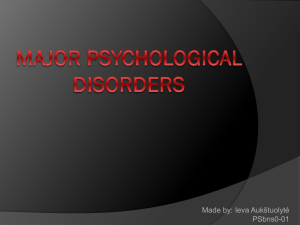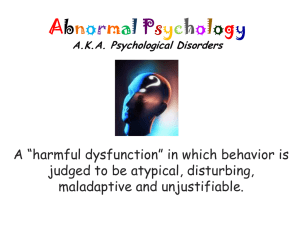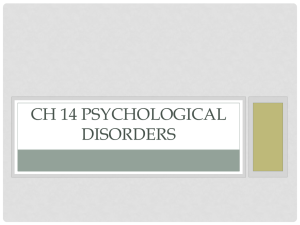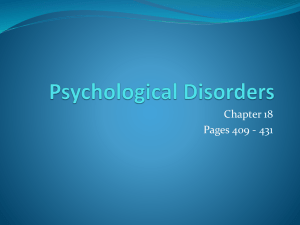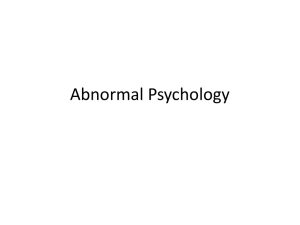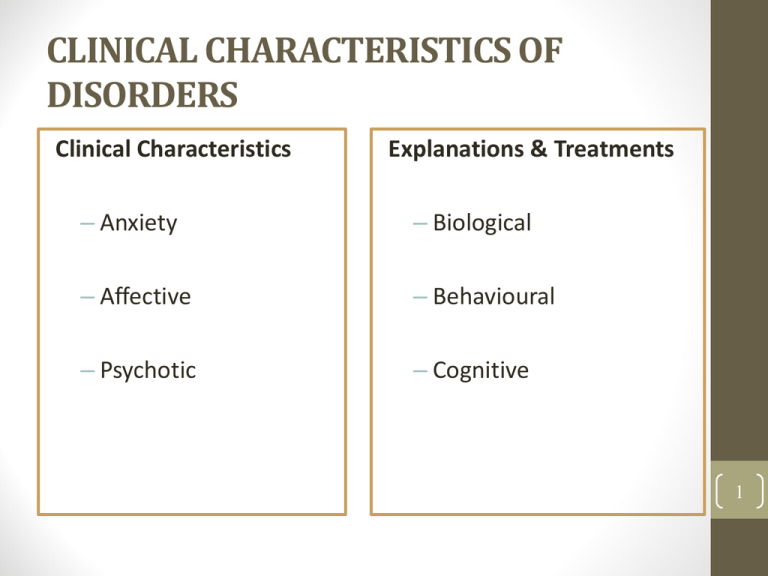
CLINICAL CHARACTERISTICS OF
DISORDERS
Clinical Characteristics
Explanations & Treatments
– Anxiety
– Biological
– Affective
– Behavioural
– Psychotic
– Cognitive
1
Clinical Characteristics
• Anxiety: Phobia
• Affective: Depression
• Psychotic: Schizophrenia
Exam Style Questions
January 2010
a) Describe the characteristics of a psychotic disorder. (10)
b) Evaluate difficulties when identifying characteristics of
psychological disorders. (15)
June 2013
a) Describe the characteristics of one anxiety disorder. (10)
b) To what extent is it valid to identify a disorder from a list of
characteristic. (15)
June 2014
a) Outline the characteristics of an affective disorder. (10)
b) Asses the reliability of identifying a disorder from a list of
characteristics. (15)
3
DSM-IV
Affective
(Mood)
Bipolar
Anxiety
Psychotic
OCD
Paranoid
Unipolar
Phobia
Residual
Dysthamic
PTSD
Undifferentiated
Cyclothamic
GAD
Catatonic
4
DSM-IV: Depression
Essential feature of specific
depression:
‘Depression is a low
emotional state
characterised by
significant levels of
sadness, lack of
energy and poor
self-worth, and
feelings of guilt’
5
6
Discussion Carousel: Depression
Why do you think depression is known as the common cold
of the mind?
How is clinical depression different to feeling “down”?
What are 3 symptoms you would associate with depression?
Why do you think twice as many women as men are
depressed?
What could the individual do to alleviate their depression?
What do you think causes depression? List as many reasons
as you can.
Do you think depression can be cured? If yes, suggest how.
7
Depression
FACT SHEET
CASE STUDY
• Definition
• William
• Prevalence
• Lewis
• Symptoms
• Tim
• Types of depression
• Kay
8
Diagnostic Criteria
Under DSM-IVR, a diagnosis of depression requires the
presence of a sad, depressed mood, plus 4 (from 8) other
criteria including the following:
• Physical/behavioural: Difficulty sleeping
• Cognitive symptoms: Recurrent thoughts of death/suicide
• Motivational: Loss of energy
9
WORD
KEY WORDS DEPRESSION
DEFINITION
Is a condition where the prevailing emotional mood is distorted or
inappropriate to the circumstances.
Describes a medical condition characterised by severely elevated mood.
Associated with bipolar disorder, where episodes of mania alternate with
episodes of depression
An illness that involves the body, mood, and thoughts and that affects the way
a person eats, sleeps, feels about himself or herself, and thinks about things.
People with this disorder cannot merely 'pull themselves together' and get
better.
As categorized by the DSM-IV, it is a form of mood disorder characterised by a
variation of mood between a phase of manic or hypomanic elation,
hyperactivity and hyper imagination, and a depressive phase of inhibition,
slowness to conceive ideas and move, and anxiety or sadness.
A mild mood disorder which is sometimes seen as more of a personality trait
than an illness. Characterised by repetitive periods of mild depression followed
by periods of normal or slightly elevated mood.
A form of the mood disorder of depression characterised by a lack of
enjoyment/pleasure in life that continues for at least six months. It differs from
clinical depression in the severity of the symptoms. While usually it does not
prevent a person from functioning, it prevents full enjoyment of life. It also
lasts much longer than an episode of major depression.
A major depressive episode that occurs without the manic phase.
10
SADGFACES
S
A
D
G
F
A
C
E
S
• Sadness, anxiety, or “empty
feelings”
• Decreased energy, fatigue, being
slowed down
• Loss of interest or pleasure in
activities that were once
enjoyed, including sex
• Insomnia
• Feelings of
helplessness/hopelessness
• Thoughts of death
• Difficulty concentrating
• Restlessness
• Chronic aches
11
Symptoms
Sadness
Appetite disturbances
Delusions and hallucinations
Guilt, worthlessness
Fatigue/loss of energy
Anhedonia (loss of pleasure)
Catatonia
Esteem low
Sleep disturbances
12
DSM-IV: Phobia
Essential feature of
specific phobia:
‘marked and
persistent fear of
clearly discernible,
circumscribed
objects or
situations’.
13
Discussion Carousel: Phobia
What is phobia?
List different types of phobia?
What are 3 symptoms you would associate with phobia?
What happens physiologically when someone has a panic
attack? What could the individual do to reduce their anxiety
levels?
What do you think causes phobia? List as many reasons as you
can.
Do you think phobia can be cured? If yes, suggest how.
14
Phobia
FACT SHEET
CASE STUDY
• Definition
• Mr L
• Prevalence
• Gareth
• Symptoms
• Rachel
• Types of Phobia
• Rebekah
• Louisa
15
Phobia DSM-IV
• Marked and persistent fear that is excessive or unreasonable, cued by the
presence or anticipation of a
• Specific object or situation (e.g., flying, heights, animals, receiving an
injection, seeing blood).
• Exposure to the phobic stimulus almost invariably provokes an immediate
anxiety response, which may take the form of a Panic Attack.
• The person recognizes that the fear is excessive or unreasonable.
• The phobic situation(s) is avoided or else is endured with intense anxiety or
distress.
• The avoidance, anxious anticipation, or distress in the feared situation(s)
interferes significantly with the person's normal routine, occupational (or
academic) functioning, or social activities or relationships, or there is
marked distress about having the phobia.
• Duration is at least 6 months.
16
PIESTRAPS
P
I
E
S
T
R
A
P
S
17
PIESTRAPS
Panic Attack
Irrational
Excessive
Shortness of breath
Terror
Reaction
Anxiety
Persisted 6months +
Specific
18
DSM-IV: Schizophrenia
Under DSM-IVR, a diagnosis of schizophrenia
requires 2 or more positive symptoms for a
period of at least 1 month.
Positive symptoms
• Auditory hallucinations
• Disorganised speech
Negative symptoms
• Losing emotional response
• Inability to feel pleasure
• Lack of motivation
• Disorganisation
Schizophrenia is a
serious mental disorder
characterised by
profound disruption in
cognition and emotion
19
Discussion Carousel: Schizophrenia
What is schizophrenia?
What are 3 symptoms you would associate
with schizophrenia?
What do you think causes schizophrenia? List
as many reasons as you can.
Do you think schizophrenia can be cured? If
yes, suggest how.
20
Schizophrenia
FACT SHEET
• Definition
CASE STUDY
• Carroll
• Prevalence
• Norma
• Symptoms
• Types of schizophrenia
• Daniel
21
Schizophrenia
TYPES
1.
Disorganised: delusions,
hallucinations, incoherent
speech, and large mood
swings
2.
Catatonic: almost total
immobility for hours at a time
3.
Paranoid: delusions of various
kinds
4.
Undifferentiated
5.
Residual: mild symptoms
SYMPTOMS
Positive symptoms
•
Delusions
• Auditory hallucinations
• Disorganised speech
• Thought disorder
Negative symptoms
• Losing emotional response
• Inability to feel pleasure
• Lack of motivation
• Poverty of speech
• Disorganisation
22
23
CSSTABSHEAD
C
S
S
T
A
B
S
H
E
A
D
24
CSSTABSHEAD
Catatonia , Paranoid, Residual, Undifferentiated
Speech disorganised
Symptoms – positive/negative
Types
Auditory hallucination
Behaviour disorganised
Split from reality
Hallucination
Emotional response impaired
Absence/present
Delusions
25
WORD
KEY WORDS SCHIZOPHRENIA
DEFINITION
A severe psychotic disorder characterized by distortions of reality,
disturbances of thought and language and withdrawal from social contact
The addition of psychotic behaviours
If someone has a persecution complex, they suffer from the feeling that
other people are trying to harm them.
the belief that you are more important or powerful than you really are
Inexpressive face, including a flat voice, lack of eye contact, and blank or
restricted facial expressions.
Inability to carry a conversation; short and sometimes disconnected replies
to questions; speaking
The absence of normal behaviours
Marked primarily by delusions that follow a theme, like persecution or
grandeur. Auditory hallucinations may accompany a delusion and are,
therefore, usually related to its theme. Symptoms common to other
subtypes, like disorganized speech and flattened affect, are not usually
prominent in episodes of paranoia, but anger, irritability, and extreme
anxiety are. People suffering from these type of delusions become
particularly preoccupied with them and may be especially prone to
violence.
26
WORD
KEY WORDS SCHIZOPHRENIA
DEFINITION
Marked by disorganized speech, behaviour, and flattened affect is
particularly disruptive. Also known as hebephrenic schizophrenia often
features fragmented speech and inappropriate or unexpected behaviour
that does not reflect ideas expressed verbally. Strange mannerisms,
gestures, and surprising behaviour are common. This type of schizophrenia
typically causes significant dysfunction in daily life, self-care, and interaction
with others, as well as notable thought disturbance and loss of goaldirected behaviour.
A form of schizophrenia characterized by a tendency to remain in a fixed
state for long periods; the catatonia may give way to short periods of
extreme excitement
The type given to a lack of catatonia, paranoia, or disorganized speech.
A type of schizophrenia that is diagnosed when positive symptoms like
delusions, hallucinations, and grossly disorganized behaviour has
disappeared. Negative symptoms remain and may be interrupted only
briefly by mildly disorganized speech or strange behaviour. When delusions
or hallucinations occur, even if infrequently, they are not serious enough to
cause severe dysfunction.
When someone believes something that is not true.
27
When you see, hear, feel or smell something which does not exist, usually
because you are ill or have taken a drug.
Exam Style Questions (ESQ)
January 2010
a. Describe the characteristics of a psychotic disorder. (10)
b. Evaluate difficulties when identifying characteristics of psychological disorders. (15)
June 2013
a. Describe the characteristics of one anxiety disorder. (10)
b. To what extent is it valid to identify a disorder from a list of characteristic. (15)
June 2014
a. Outline the characteristics of an affective disorder. (10)
b. Asses the reliability of identifying a disorder from a list of characteristics. (15)
28
Diagnosis
Purpose
• To identify groups of similar sufferers so that psychiatrists and
psychologists may develop explanations and methods to help
those groups
• Billing purposes. The government and many insurance
companies require a diagnosis for payment
Techniques
• Observation
• Interview
• Psychological tests (e.g. IQ tests)
• Brain scans
29
Exam Style Question
Plan and prepare a response to the question
January 2010
a) Describe the characteristics of a psychotic disorder. (10)
b) Evaluate difficulties when identifying characteristics of
psychological disorders. (15)
30
b. Evaluate difficulties when identifying
characteristics of psychological disorders
1.
2.
3.
4.
5.
6.
7.
Highly subjective
Method: Self-Report
Overlap between disorders
Symptoms may not always be evident
Ethnocentricism
Gender Bias
Type 1 & 2 Error
31
Evaluate difficulties when identifying
characteristics of psychological disorders
1.
2.
3.
4.
Highly subjective - a lot of the descriptions of characteristic refer to
"excessive" or "irrational", but these are subjective not objective
descriptions. This could lead to poor validity and reliability.
Requires self-report from individuals who may not perceive their
behaviour as abnormal or dysfunctional, or who may be prone to
lying/disordered thoughts and social desirability. Validity is an issue
here too.
Significant overlap between disorders e.g. loss of pleasure is a factor in
depression and schizophrenia, whilst bipolar disorders and
schizophrenia can feature delusions and disordered actions. Anxiety is
also somewhat common amongst people who are depressed, due to
feelings of worthlessness and pessimistic depressive thought patterns.
Symptoms may not always be evident in psychiatric evaluations: such
as loss of pleasure in daily activities, or disordered actions. Thus it's
unobservable. However you do of course have the patient to recall
these.
32
5. Ethnocentrism: This questions the international validity of diagnoses. For
example they may be biased to certain countries, certainly the DSM is an
American invention by the APA and therefore may bring into play wrong
diagnoses based on racism.
6. Gender bias: Ford and Widiger (1989) raised the fundamental question of why
those involved in diagnosing and classifying disorders are predominantly men,
when those being diagnosed and treated are mainly women? The issue with this
is that normal stereotypical gender roles might be incorrectly labelled as
pathological. When presented with identical case histories (apart from gender control), 354 psychologists diagnosed women mainly with histrionic personality
disorder, whereas men were more likely to be diagnosed with anti-social
personality disorder.
7. Type 1 and type 2 Errors: Rosenhan's study brought psychiatrists type 2 errors
to light (diagnosing someone with an illness when in fact they do not have one).
• Type 1 errors on the other hand consist of diagnosing a patient without an
illness when in fact they do have one.
• Obviously Type 2 would be the safer option, to ensure extra tests and care
is taken (just incase the patient really does need it), nevertheless it is a
waste of time.
33
Exam Style Question
Plan and prepare a response to the question
June 2013
(A) Describe the characteristics of one anxiety disorder. (10)
(B) To what extent is it valid to identify a disorder from a list
of characteristic. (15)
34
b. To what extent is it valid to identify a disorder
from a list of characteristic. (15)
Validity of diagnosis: Does the person diagnosed have real symptoms with
a real underlying cause? (the illness is not socially constructed, the person
is not faking) Diagnoses may be consistent but what if they are wrong?
•
•
•
•
Fundamental attribution error: There is a tendency of practitioners of
overemphasizing dispositional rather than situational causes of
behaviour when diagnosing patients.
Self-Fulfilling prophecy: The labelling of patients with certain
disorders may affect the practioners perceptions of them (compare
with researcher bias), patients may act the label that has been given
to them. The label itself may simplify a problem that is highly complex
Insanity defense: People may fake mental illness in order to avoid
punishment
Co-morbidity: There are significant individual differences for mental
disorders. An individual may have multiple mental disorders
35
Research Evidence:
1.
Szaz 1967: Many disorders may be culturally constructed. If the
biological causes of the mental disorder are known, the individual
may be diagnosed with mental disorder (the mental illness
criterion). If there is no biologically underlying cause of the
disorder, it is better to claim that the individual has problems with
living.
2.
Rosenhan's ( 1973) classic study shows this when nearly all psuedopatients were incorrectly diagnosed with schizophrenia. 8 sane
people could get admitted to mental hospitals merely by claiming to
hear voices.
Rosenhan (1973): When a teaching hospital was told to expect
pseudo-patients, they suspected 41 out of 193 genuine patients of
being fakers.
3.
36
• Temerline (1970): Clinically trained psychiatrists were influenced in
their diagnosis by hearing the opinion of a respected authority.
(expert influence). Participants watched a video-taped interview of a
healthy individual. The authority claimed, even though the person
only seemed to be neurotic (distress where behaviour is not outside
social norms, patient has not lost touch with reality) he was actually
psychotic (behaviour is outside social norms, loss of touch with
reality)
• Chapman & Chapman (1967): Beginning clinicians observed draw-aperson test drawing randomly paired (unknowingly to participants)
with symptom statements of patients. Although the relationship
between symptoms and drawings were absent, participants rated a
high associative strength between symptom and drawing
characteristics (e.g. paranoia and drawing big eyes)
• Lipton & Simon (1985): 131 patients were randomly chosen at a
New York hospital. Initially there were 89 patients diagnosed with
schizophrenia, eventually only 16. Initially, there were 15 diagnosed
with depression, eventually there were 50.
37
Exam Style Question
Plan and prepare a response to the question
a. Outline the characteristics of an affective disorder (10
marks)
b. Asses the reliability of identifying a disorders from a list of
characteristics (15 marks)
38
Asses the reliability of identifying a disorders
from a list of characteristics (15 marks)
Reliability of diagnosis: Will different diagnosticians
using the same classification system arrive at the same
diagnosis?
The consistency of diagnoses. We would expect all
psychiatrists to diagnose the same set of symptoms in
the same way. The reliability of earlier systems for
diagnosis, e.g. DSM-II, was very poor, but it has been
improved in revisions of the systems, e.g. DSM-IV-TR.
39
Asses the reliability of identifying a disorders
from a list of characteristics (15 marks)
• Pedersen et al., (2001) researchers compared the consistency of
diagnoses and found that 71% of psychiatrists agreed with the
ICD-10 definition of depression when assessing 116 patients
(inter-rater relibility).
• Beck (1962): Agreement between two psychiatrists on diagnosis
for 153 patients was 54 %. This was due to vague criteria for
diagnosis and different ways of psychiatrists to gather
information
• Cooper et. al. (1972): When shown the same video clips, New
York psychiatrists are twice as likely to diagnose schizophrenia
than London psychiatrists. London psychiatrists were twice as
likely to diagnose mania or depression than New York
psychiatrists
• Di Nardo (1993): Two clinicians separately diagnosed 267 people
seeking treatment for anxiety and stress disorders. They found
higher reliability for obsessive compulsive disorder but lower
reliability for major depression
40
Conclusion
• There is a large amount of research supporting
the view that the reliability and validity of
diagnosis are poor. This is due to many reasons,
e.g. a possible social construction of mental
illness, poor diagnostic tools, the possibility of
faking, social influence, errors in attribution by
practitioners and labeling
• Ethnocentricism: There are significant individual
and cultural differences for the symptoms of
mental disorders. An individual may have
multiple mental disorders
• Ethical Issues: A wrong diagnosis may lead to a
social stigma.
Counter argument
• There are methodological problems with the studies on
validity and reliability (researcher bias, generalisability,
ecological validity).
• Revised diagnostic tools are higher in reliability than
earlier versions, e.g. DSM-IV-TR.
• Many people do seek help voluntarily for disorders
(which may mean that the disorder is valid).
• The reliability of diagnosis is high for some disorders, e.g.
obsessive compulsive disorder.
• There are many similarities of disorders across cultures.
• Diagnostic systems do not classify people, but the
disorders that they have.




